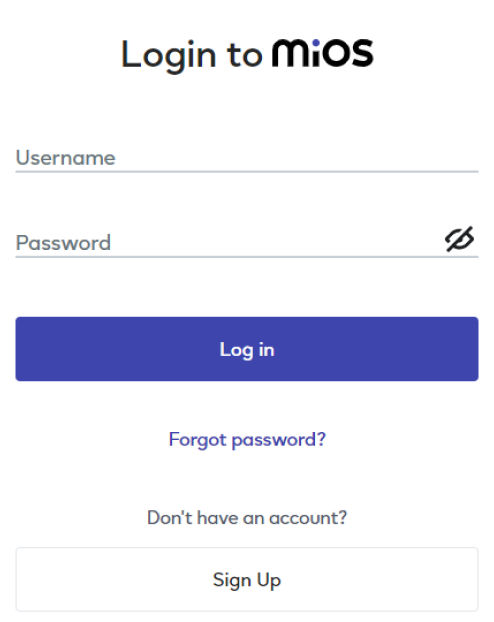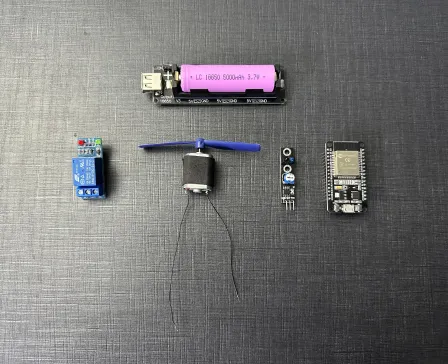
Automate your life with EzloPi!
Enhance safety using proximity sensor
The EzloPi smart devices provide automation through simple, customizable use with our open-source EzloPi platform, making daily life easier and improving human-machine interactions.
Before moving into this example, it is very important to know about the device registration, provisioning and converting the ESP32 device into an EzloPi device along with knowledge of Web Flasher, MiOS Mobile Application for Android/iOS and the MiOS Web Application.
1. About this example
This project involves interfacing an FC-51 proximity sensor with a DC motor using the EzloPi device to enhance safety measures. The FC-51 sensor will detect the presence of a person or object within a specified range. Upon detection, the EzloPi device will process the signal and activate the DC motor, which can be used to trigger a safety mechanism, such as stopping a machine or closing a barrier. This setup aims to prevent accidents and ensure a safer environment by automatically responding to the presence of individuals near potentially hazardous equipment. The integration leverages the ease of use and flexibility of the EzloPi device for efficient and reliable operation.
2. Project Demonstration Video
Welcome to the project demonstration video section. The following video showcases the key aspects of Enhance safety using proximity sensor, providing a visual walkthrough of its implementation.
3. Circuit Diagram & Interface
The following components are required for interfacing with the EzloPi device:
- ESP32 as an EzloPi smart device
- FC-51 Proximity sensor
- Single channel relay shield
- DC Motor
- DC power source
The wiring diagram of ESP32 30 pin is represented as follows:

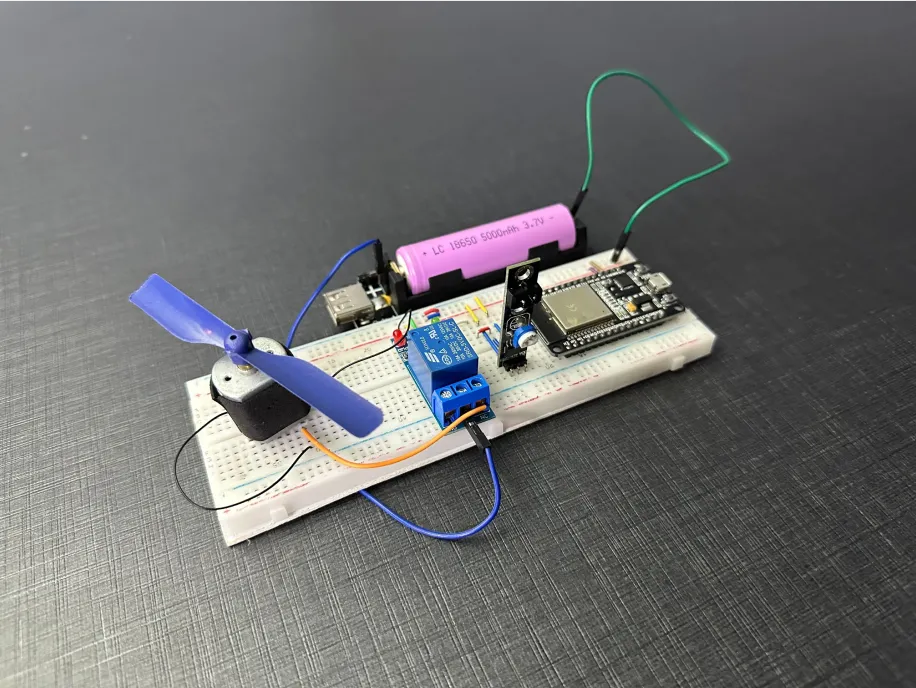
The following connections are made in order to complete the circuit setup.
From ESP32 to the FC-51 Proximity sensor:
| ESP32 | FC-51 Proximity sensor |
| 3V3 | VCC |
| GND | GND |
| D15 | OUT |
From ESP32 to the Single Channel Relay module:
| ESP32 | Relay Module |
| GND | + (VCC) |
| GND | - (GND) |
| D4 | S (Signal) |
From Relay Module to DC Motor & Power Supply:
| Relay Module | Power Supply |
| NO | Positive Terminal |
| NC | Negative Terminal & 2nd Terminal of Motor |
| COM | 1st Terminal of Motor |
4. Interfacing the DC Motor with Proximity sensor using the EzloPi Web Flasher
1. Set up your device/hardware by visiting config.ezlopi.com
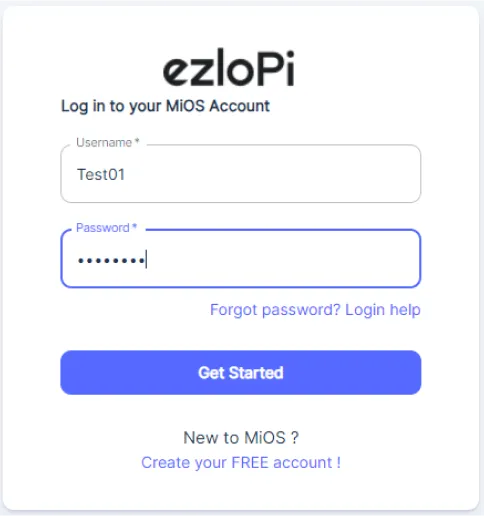
- Log in using the credentials which you just set earlier while signing up.
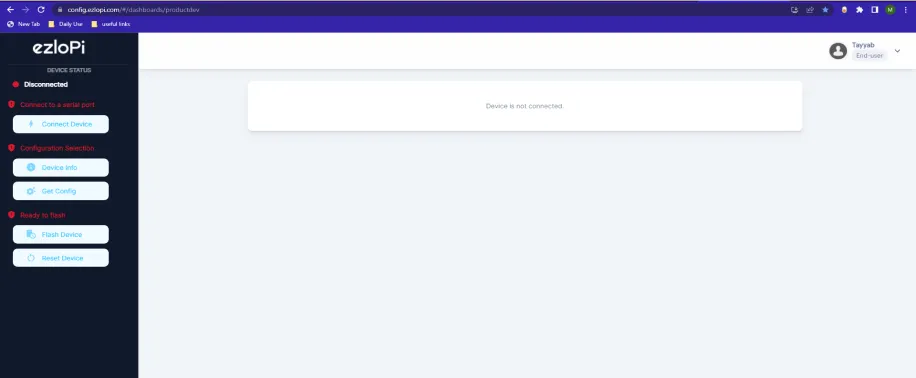
- Now, click on the Connect Device button and a pop-up window will appear.
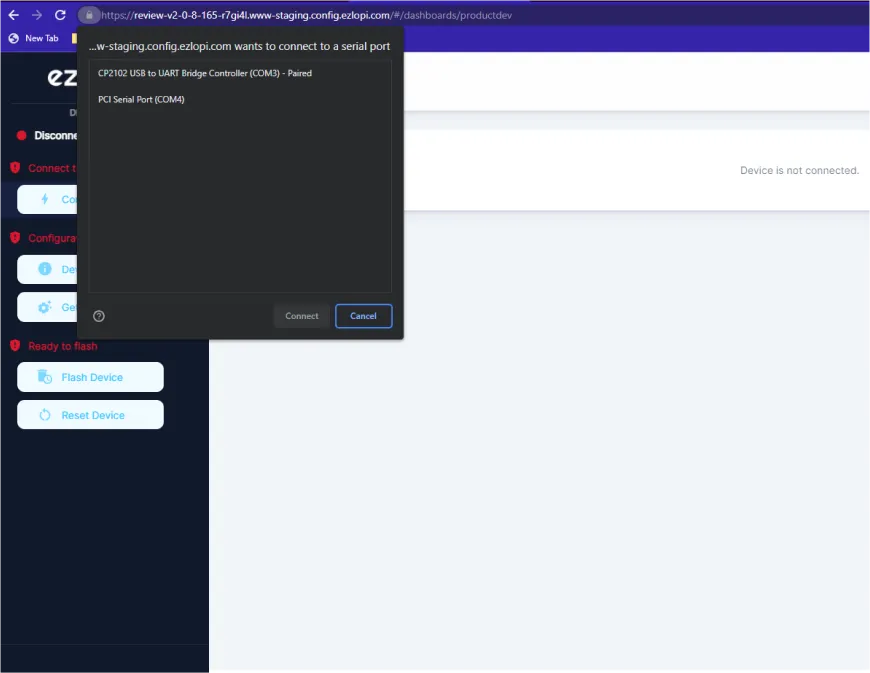
- Now, select COM Port to which your ESP32 device is connected. In our case, the COM3 port is used.
Click Connect
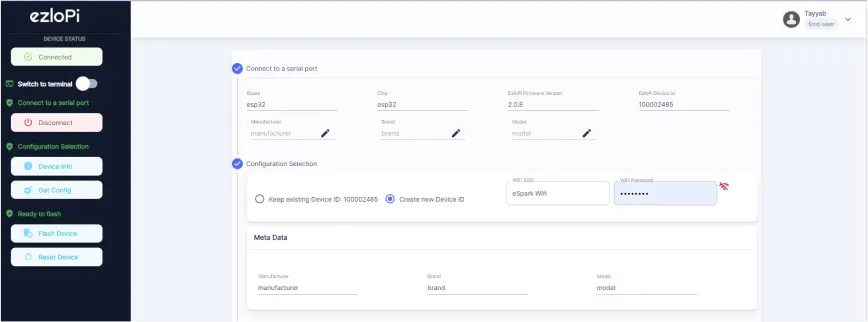
- If you are new to this and it's your first time configuring, select Create new Device ID. Enter Wifi SSID and Wifi Password.
- In the Device Configuration, tab click on Digital Input.
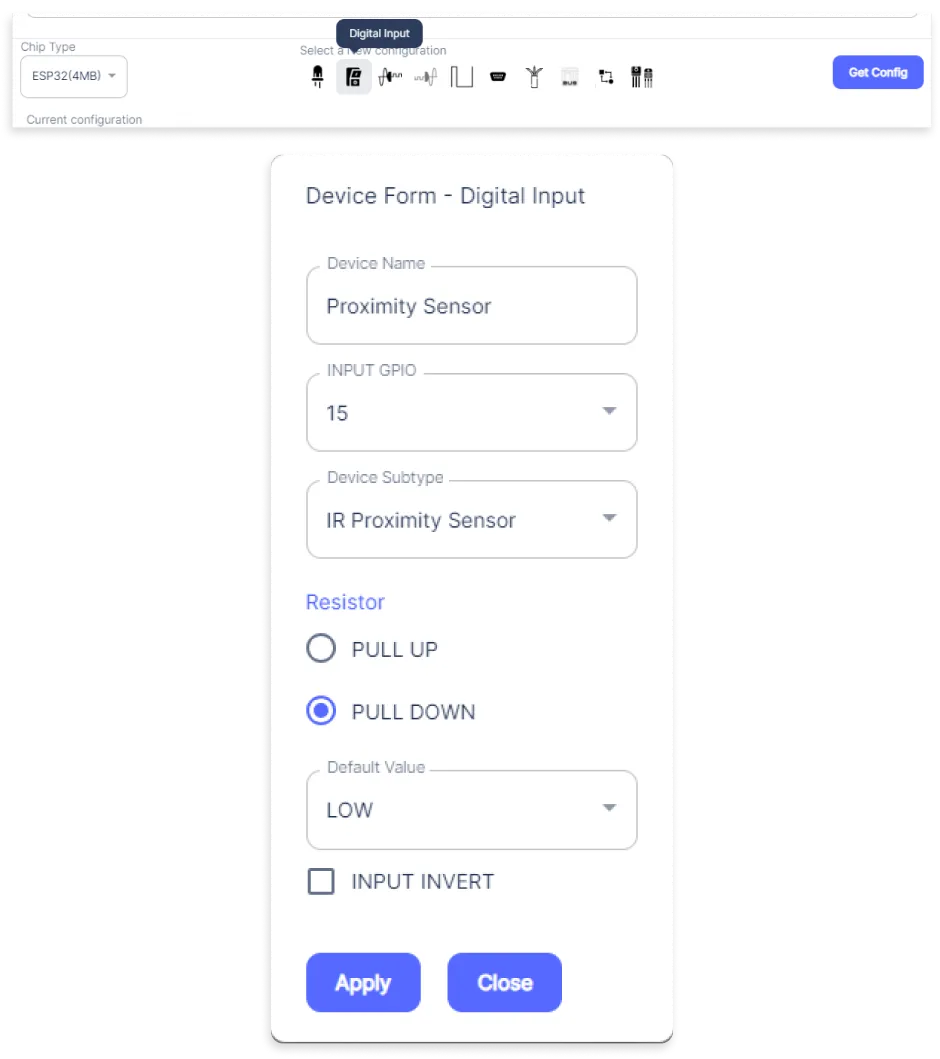
- A window will be opened for inputting the following parameters:
- Set a Device name of your choosing. In our case, we set it to Proximity Sensor.
- Set OUT GPIO to 15.
- Set Device Subtype to IR Proximity Sensor.
- Set Resistor to PULL DOWN.
- Set default value to LOW.
- Now Click the Apply button.
- In the Device Configuration, tab click on Digital Output.
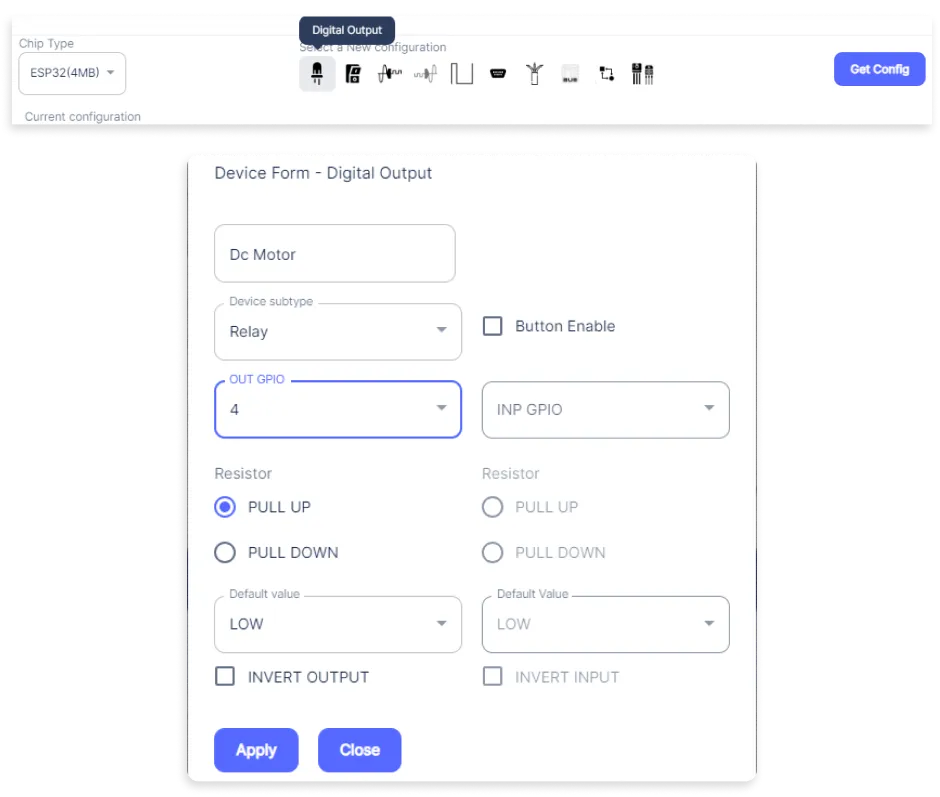
- A window will be opened for inputting the following parameters:
- Set a Device name of your choosing. In our case, we set it to DC Motor.
- Set Device Subtype to Relay.
- Set OUT GPIO to 4.
- Set Resistor to PULL UP.
- Set default value to LOW.
- Now Click the Apply button.
- After clicking the apply button you can see a table of your setting in the device configuration tab.
- Press the Flash Device button.
- A window will appear on the bottom right side of the screen displaying “Please press BOOT button while flashing begins.”

- Hold the BOOT button down until the next window appears on the bottom right side of the screen which says “Installation prepared. Please release the boot button now.”
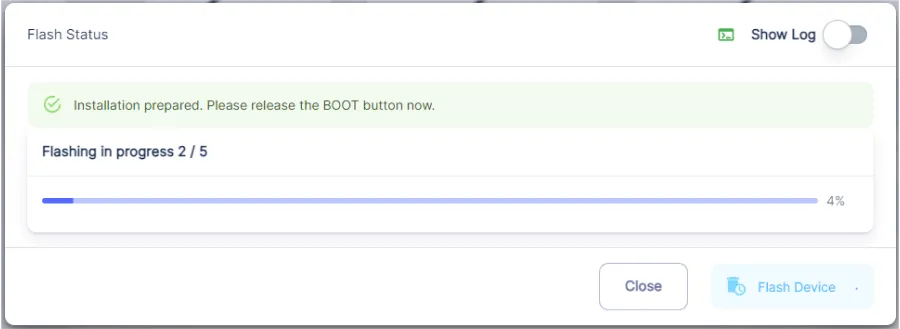
- Release the BOOT button from your ESP32 when this pop-up on the bottom right window appears.

- After some time, a popup will appear saying Device Flashed Successfully! This means that your device has been set up successfully.
5. MiOS Web Dashboard
- After configuring the controller with the EzloPi web flasher, head to ezlogic.mios.com
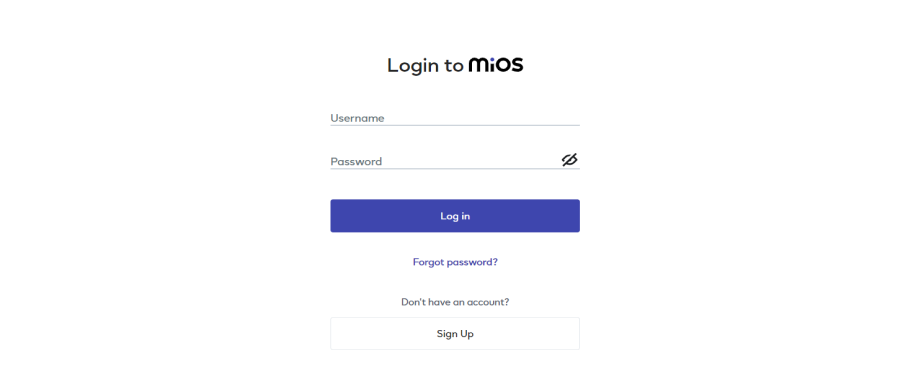
- Use the same credential to log in that you used for configuring the controller with the web flasher.
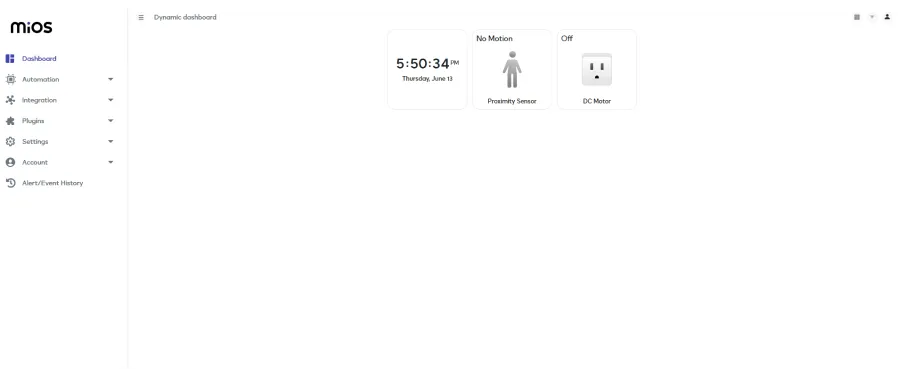
- On the MiOS web dashboard, you will be able to see the tiles for proximity sensor and motor. These tiles show the status of all the devices. For now, no device is triggered/turned on.
MeshBots:

- On the right side of the screen under Automation, click on MeshBots.
- On meshbot screen, click on Create new MeshBot button present on the top right corner of the screen.
- After clicking on Create new MeshBot you will see new options, now under Automation MeshBot click on Local.
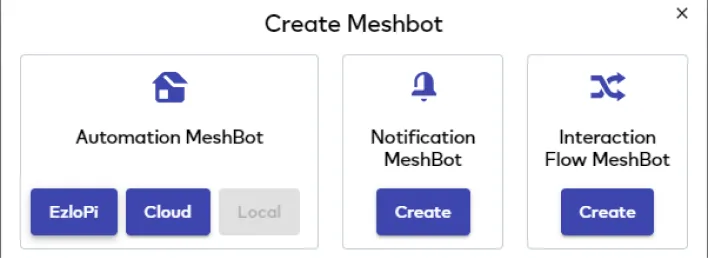
- On the next screen you will see that we can create a name of our choosing, in this case we write it as Test002.

- In the trigger tab you can set the TRIGGER for your device and in the ACTION tab you can set the action to be performed based on the trigger which you have created.

- Set these things in TRIGGER section:
- Set Node Type to Device.
- Set the Node to Proximity Sensor.
- Set the Capability to Motion.
- Set the value to True.

- Set these values in the True part of the ACTION section.
- Set Node Type to Device.
- Set Controllable Type to DC Motor.
- Set the Capability to Switch.
- Set the value to false.

- Set these values in the False part of the ACTION section.
- Set Node Type to Device.
- Set Controllable Type to DC Motor.
- Set the Capability to Switch.
- Set the value to true.
- After clicking the apply button you can see a table of your setting in the Current configuration tab.


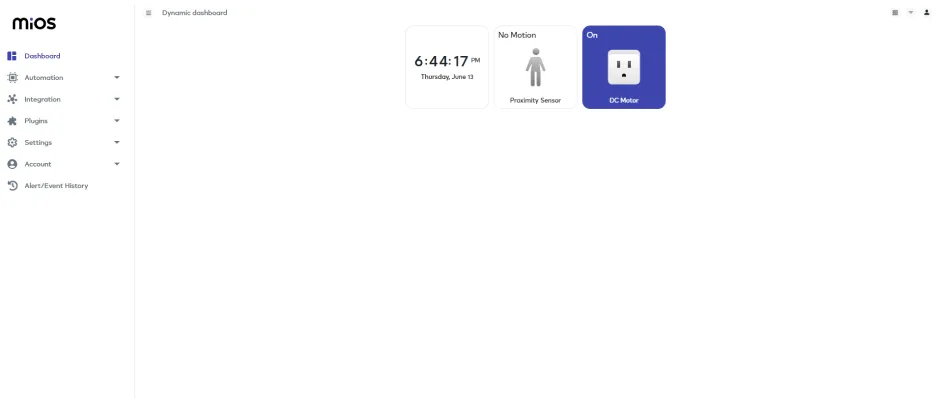
- As we can see, our motor is running, when the proximity sensor detects the presence of a person or a pet, it gets triggered and our motor stops because of the rules we have set in the meshbot.
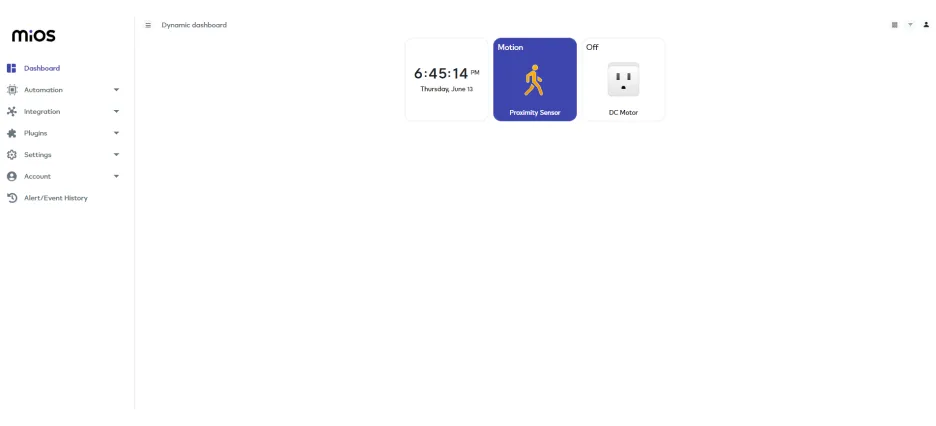
- As we can see, when our proximity sensor gets triggered by a person or pet as shown by the tile, the motor stops because of the rules we have set in the meshbot.
6. MiOS App
You can download the MIOS Android app from the Google Play Store and Apple App Store.
- After downloading the app, proceed to install the application and open it.
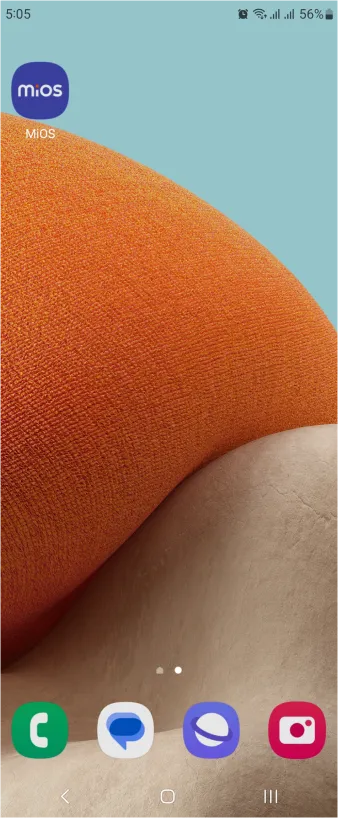
- Using the MIOS mobile application, create a new Ezlo Cloud account using the sign-up option. If you already have an account, you may proceed to log in.

- After successfully logging in, you will be able to see the number of controllers connected such as a lamp, fan, or any other device in the MiOS app. Tap on any controller of your desired ID:
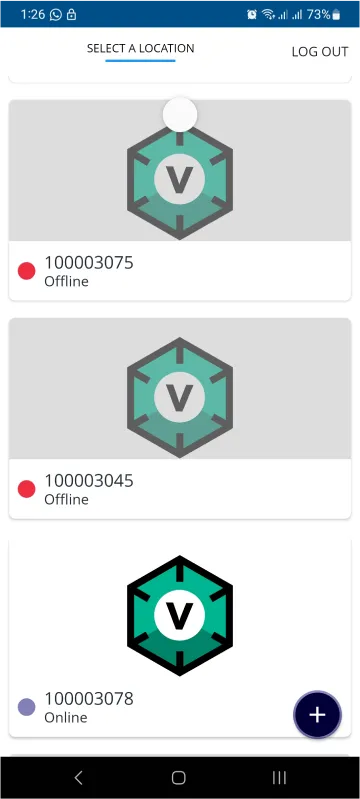
- You will be able to see the status of your controller whether it is online or offline. Access the device dashboard, and tap the device. The following view of the dashboard will appear:
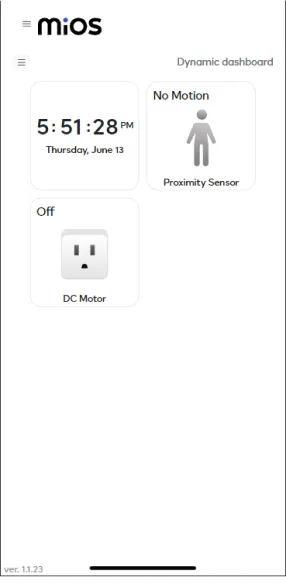
- On the MiOS mobile dashboard, you will be able to see the tiles for proximity sensor and motor. These tiles show the status of all the devices. For now, no device is triggered.

- As we can see, our motor is running, when the proximity sensor detects the presence of a person or a pet, it gets triggered and our motor stops because of the rules we have set in the meshbot.
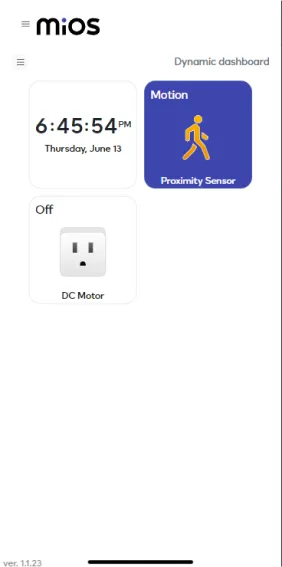
- As we can see, when our proximity sensor gets triggered by a person or pet as shown by the tile, the motor stops because of the rules we have set in the meshbot.
6. MiOS Web Application
- After configuring the controller with the EzloPi web flasher, head to ezlogic.mios.com
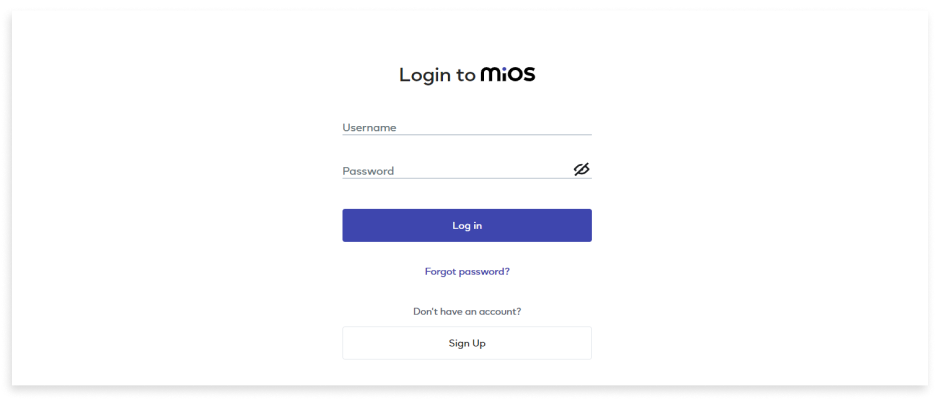
- Use the same credentials to log in that you used for configuring the controller with the web flasher.

- After opening the MiOS mobile app dashboard, We can see that when the Light is operated from the First Floor Button, The Light turns on because of the rule we have set in the meshbot.

- Now, We can see that when the Light is operated from the Ground Floor Button, The Light turns on because of the rule we have set in the meshbot.

eZlopie Products A single-channel 5V relay module $00.00

eZlopie Products Momentary switch $00.00

eZlopie Products Level Shifter Module (BSS138) $00.00

eZlopie Products ESP32
$00.00

eZlopie Products AC Lamp and Holder
$00.00











